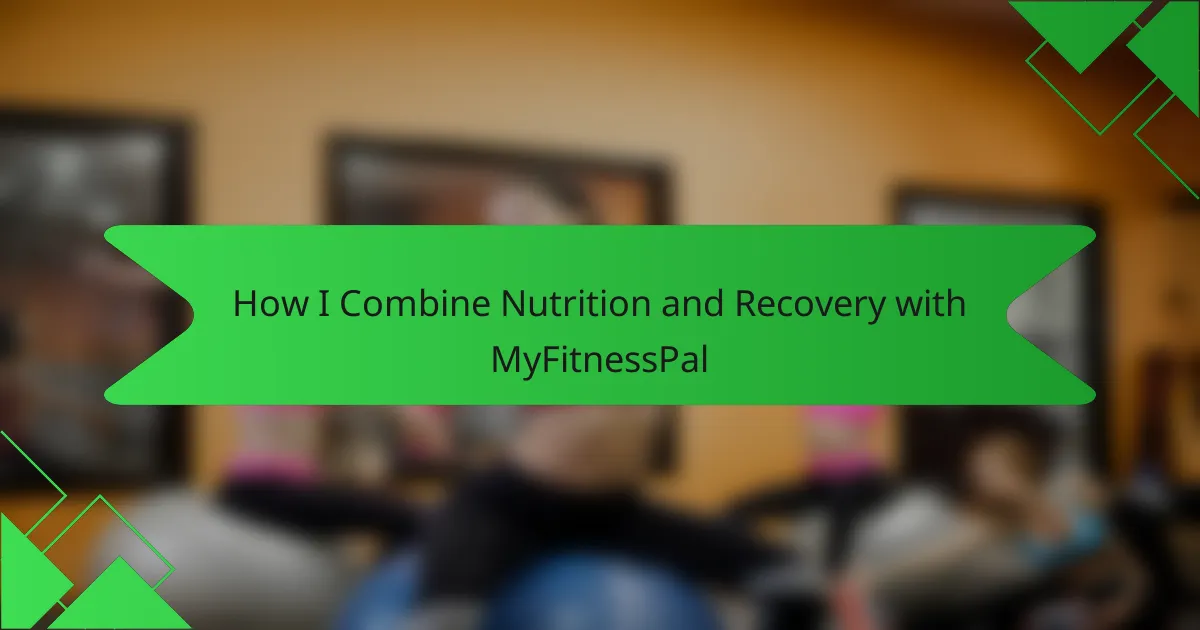Key takeaways
- Nutrition for obstacle course racing focuses on smart eating: balancing carbs for energy, proteins for muscle repair, and fats for sustained performance.
- Recovery involves intentional practices like quality sleep, hydration, and post-race nutrition to reduce soreness and enhance preparedness for future challenges.
- MyFitnessPal is a valuable tool for tracking nutrition and recovery, offering features such as a food diary, exercise logging, and community support to optimize performance.
- Customizing MyFitnessPal allows racers to set tailored nutrition goals, monitor hydration, and log energy levels for improved training balance and recovery insights.

Understanding Obstacle Course Racing Nutrition
Obstacle course racing pushes your body in unique ways, blending endurance, strength, and agility. Understanding nutrition for this sport means more than just counting calories—it’s about fueling your muscles to power through mud, climbs, and sprints. Have you ever felt drained halfway through a race? I have, and that’s when I realized nutrition needed to be as strategic as my training.
What I’ve learned is that timing and balance matter. Carbs provide quick energy bursts, while proteins help repair muscle damage after those brutal climbs. Fat plays its role too, keeping energy steady during longer races. It’s not just about eating more but eating smart—knowing what helps me perform better and recover faster.
I often wonder why so many overlook recovery nutrition when training for obstacles. From my experience, what you eat after a race or hard workout is just as crucial as what you eat before. Replenishing nutrients reduces soreness and prepares your body for the next challenge, keeping you fresh and injury-free. Isn’t that what we all want as obstacle racers?

Basics of Recovery for Racers
Recovery for obstacle course racers isn’t just about resting; it’s about intentional practices that help your body heal and prepare for the next challenge. From my own experience, I’ve found that paying attention to sleep quality and hydration has dramatically improved how I bounce back. Combining these basics with proper nutrition, tracked through MyFitnessPal, gives me a clear picture of what fuels speedy recovery.
| Recovery Aspect | My Approach |
|---|---|
| Sleep | Aim for 7-8 hours, track sleep quality with MyFitnessPal notes |
| Hydration | Log daily water intake, prioritize electrolyte balance |
| Nutrition | Focus on protein and anti-inflammatory foods, monitor macros via MyFitnessPal |
| Active Recovery | Include light stretching or yoga sessions to ease muscle tension |

Overview of MyFitnessPal Features
MyFitnessPal offers a range of features that make tracking nutrition and recovery straightforward, especially for athletes like me tackling obstacle course races. The app’s extensive food database helps me stay on top of my calorie and nutrient intake without feeling overwhelmed. Plus, logging exercise and syncing with other apps keeps my recovery progress visible and motivating.
| Feature | Benefit for Obstacle Course Racers |
|---|---|
| Food Diary | Easy tracking of calories and macronutrients supports fueling for intense training. |
| Exercise Logging | Monitors workouts and estimates calories burned to balance nutrition and recovery. |
| Recipe Importer | Simplifies meal planning by breaking down homemade meals into nutritional info. |
| Progress Reports | Visualizes trends in diet and exercise, helping optimize race prep strategies. |
| Community Support | Provides motivation through forums and challenges tailored to fitness goals. |
![]()
Tracking Nutrition with MyFitnessPal
When I first started using MyFitnessPal to track my nutrition, it felt like a game-changer. Being able to log each meal and instantly see how many carbs, proteins, and fats I was consuming helped me identify gaps I’d never noticed before. Have you ever wondered if your post-race snack actually supports recovery? This app made those questions clear for me.
One feature I rely on is the detailed breakdown of macronutrients. It’s one thing to eat healthy foods, but another to ensure they serve the energy demands of obstacle racing. Tracking those macros showed me when I needed more protein to rebuild muscles or extra carbs before a long training day. It’s like having a nutrition coach in your pocket.
Sometimes, I catch myself obsessing over perfect logging, and then I remind myself that consistency beats perfection. MyFitnessPal lets me go back and adjust meals, which eased the pressure while keeping me accountable. Would you agree that sustainable habits fuel long-term progress better than crash diets? For me, this balance is key.

Monitoring Recovery Using the App
Monitoring recovery using MyFitnessPal has become an essential part of my obstacle course racing routine. I rely on the app to track not just my calorie intake but also how my body feels day-to-day, helping me avoid overtraining. For example, by logging my meals and physical feelings, I quickly realize when I need to prioritize rest or adjust my nutrition for better recovery.
Here’s a quick comparison of how I use MyFitnessPal for nutrition tracking versus recovery monitoring:
| Feature | Nutrition Tracking |
|---|---|
| Purpose | Ensuring balanced macronutrients for performance |
| What I Log | Calories, macros, hydration |
| Frequency | Every meal and snack |
| Benefit | Optimized fuel for training sessions |
| Feature | Recovery Monitoring |
| Purpose | Identifying energy levels and signs of fatigue |
| What I Log | Meals, sleep quality, mood, soreness |
| Frequency | Daily reflections and adjustments |
| Benefit | Prevention of injury and better training balance |

Customizing MyFitnessPal for Racing Goals
Customizing MyFitnessPal for my racing goals has been a game-changer in how I approach both nutrition and recovery. I remember the first time I adjusted my calorie and macronutrient targets specifically for an obstacle course race—it felt like I finally had a plan tailored to the unique demands of the sport, helping me fuel better and recover faster.
To get the most out of MyFitnessPal, I focus on these key customizations:
– Adjusting macronutrient ratios to prioritize protein and healthy fats for muscle repair
– Setting nutrient targets based on race intensity and training phases
– Logging hydration alongside food intake to support recovery
– Creating custom meal and snack entries for on-the-go fueling
– Using the notes feature to track energy levels and sleep quality for better insight
